“And somebody like Gnonto, would he be Premier League ready in your mind?” came the question.
It was 19 August 2022 – a day before Leeds were set to host Chelsea – with Jesse Marsch doing his usual pre-match press conference. The defining days of the transfer window were fast approaching, and an interest in Wilfried Gnonto, an 18-year-old forward at FC Zürich, had been circulating in the days leading up to the match. With Marsch rarely one to return an abrupt answer, it was always worth asking him to shed some light.
Before the question from the BBC’s Adam Pope could even be completed, though, the Leeds coach interjected.
“No, no… no.”
What followed from Marsch assured that Gnonto was not a player for the present in their mind, nor a signing that Leeds were even sure they could secure before 2023. The Italian was someone they were aware of but not bound to, and their attacking plans wouldn’t hinge on an 18-year-old. Besides, in the cut-throat world of Premier League management, he might even have been a target whose arrival would come in the post-Marsch era at Elland Road – depending on how the intervening months went.
Except, things didn’t quite go to plan on the transfer front – and few will be relieved as the American that they didn’t.
After ultimately signing in the final hours of the transfer window (as a late response to Dan James leaving for Fulham), Gnonto has gone on to obliterate any realistic projection of what he’d be able to bring to the club in the short-term. The Italian needed just five games in the u21s before becoming a first teamer, and five starts for the first team to become arguably Elland Road’s star attraction.
“You could say I could revise my (original) statement,” Marsch would later add, referring to his original doubts about whether Gnonto was ready.
But how did he invade Leeds’ plans so dramatically, and so quickly?
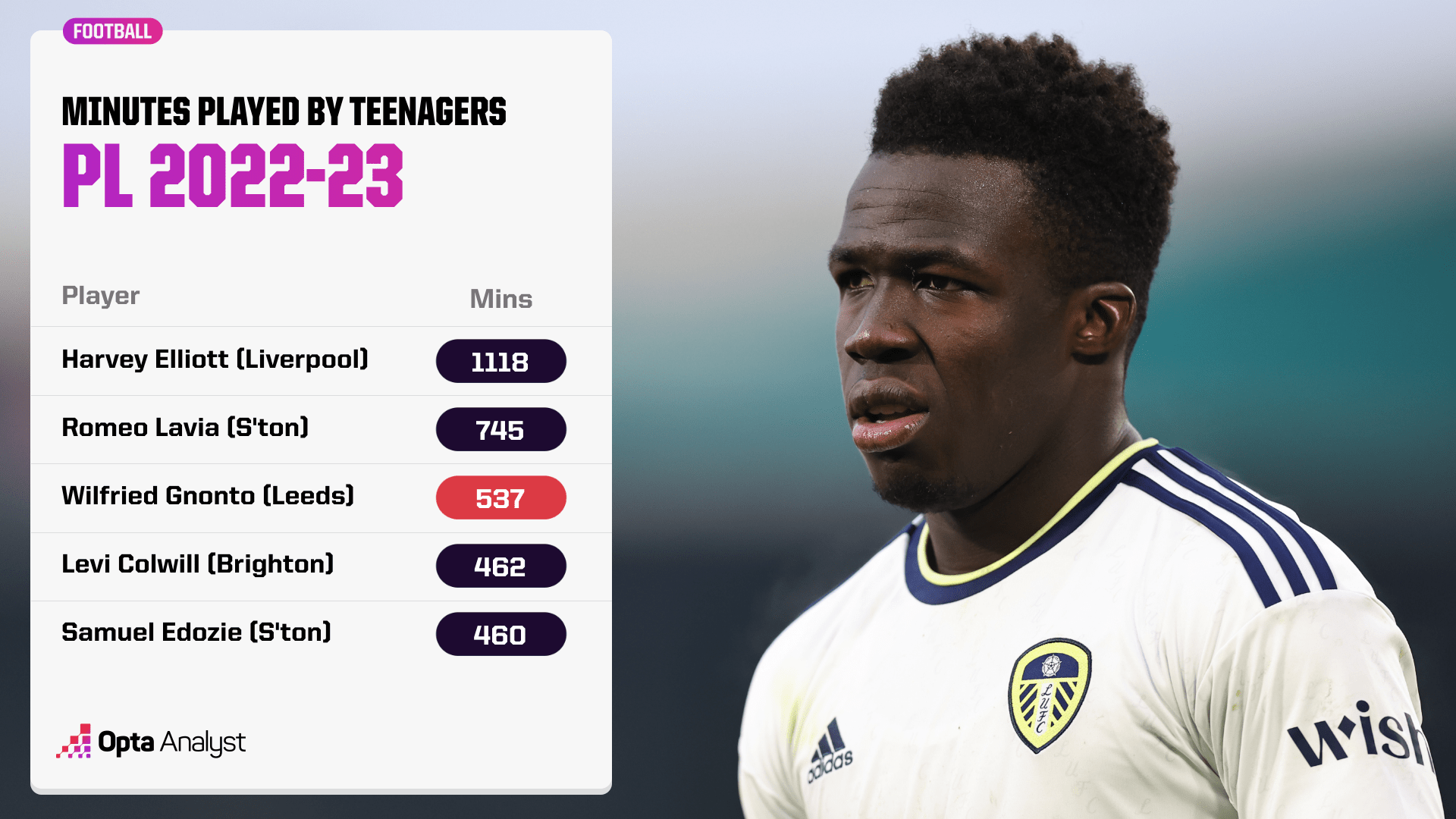
From the moment he first stepped on the pitch in a Premier League match, Gnonto’s game has been characterised by an inherent ability to agitate events. Not the type of agitating that provokes emotions or reactions in opponents per se (although it often does), but the type that makes games more uncomfortable for opponents in his vicinity.
Gnonto is just difficult to get to grips with for defenders, and he achieves it in a multitude of ways.
The starting point and most striking feature is his physical make-up. As one of the smallest players in the Premier League – if not the smallest – his ultra-low centre of gravity is an aspect that infuses much of what he does, and what makes him distinct to other wide players. In the absence of blinding, kick-and-run type speed, the teenager does his damage through quick shifts and changes of direction. And once a player of his build – small but stocky – finds a slight advantage, he’s a serious problem for scrambling defenders.
Since his first start for Leeds in November, Wilfried Zaha (17) is the only attacking player who has been fouled more often than Gnonto (16) in the Premier League. What’s more, Jack Grealish and Michael Olise (four each) are the only attacking midfielders or wingers to have won more fouls resulting in opposition yellow cards than the Italian (three). All three of those bookings – courtesy of Kieran Trippier, Rico Lewis and Rodri – came in similar fashion, with Gnonto being halted during dangerous runs upfield.
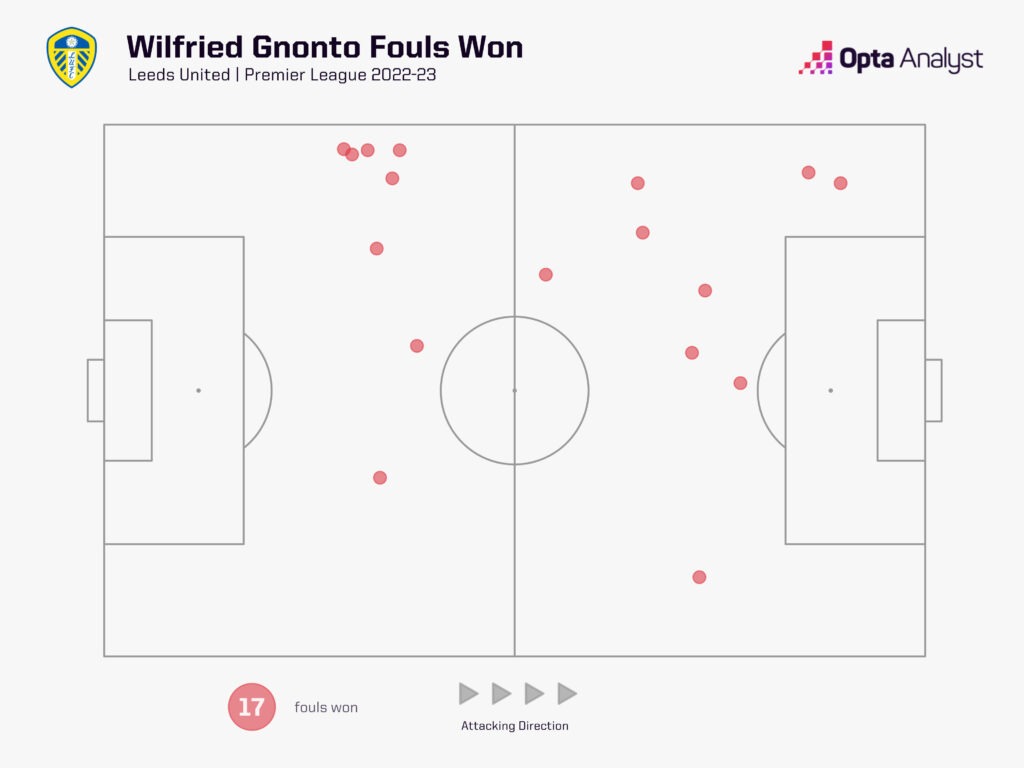
The key for Gnonto is that he understands how to leverage his unorthodox stature. Whether it’s receiving a ball deep in his half with a player on his back or trying to round the corner on a defender in the final third, he’s frequently able to duck inside his opponent – or even underneath – to protect the ball and secure the advantageous position. What makes it difficult for his marker is that it’s not easy to establish contact with Gnonto when side-by-side, given the Italian’s crouching style of movement.
In the examples shown below, Gnonto draws a foul on every occasion by touching the ball ahead and shifting himself into and/or underneath his opponent. With the foul committed by Josh Dasilva in Leeds’ last game (shown in the bottom left), the Brentford midfielder couldn’t get any meaningful contact on him or use his shoulder due to Gnonto’s low dribbling style. And once Dasilva had given up the inside position, it was a choice of either surrendering the transition or allowing the tangle of legs and resulting foul.
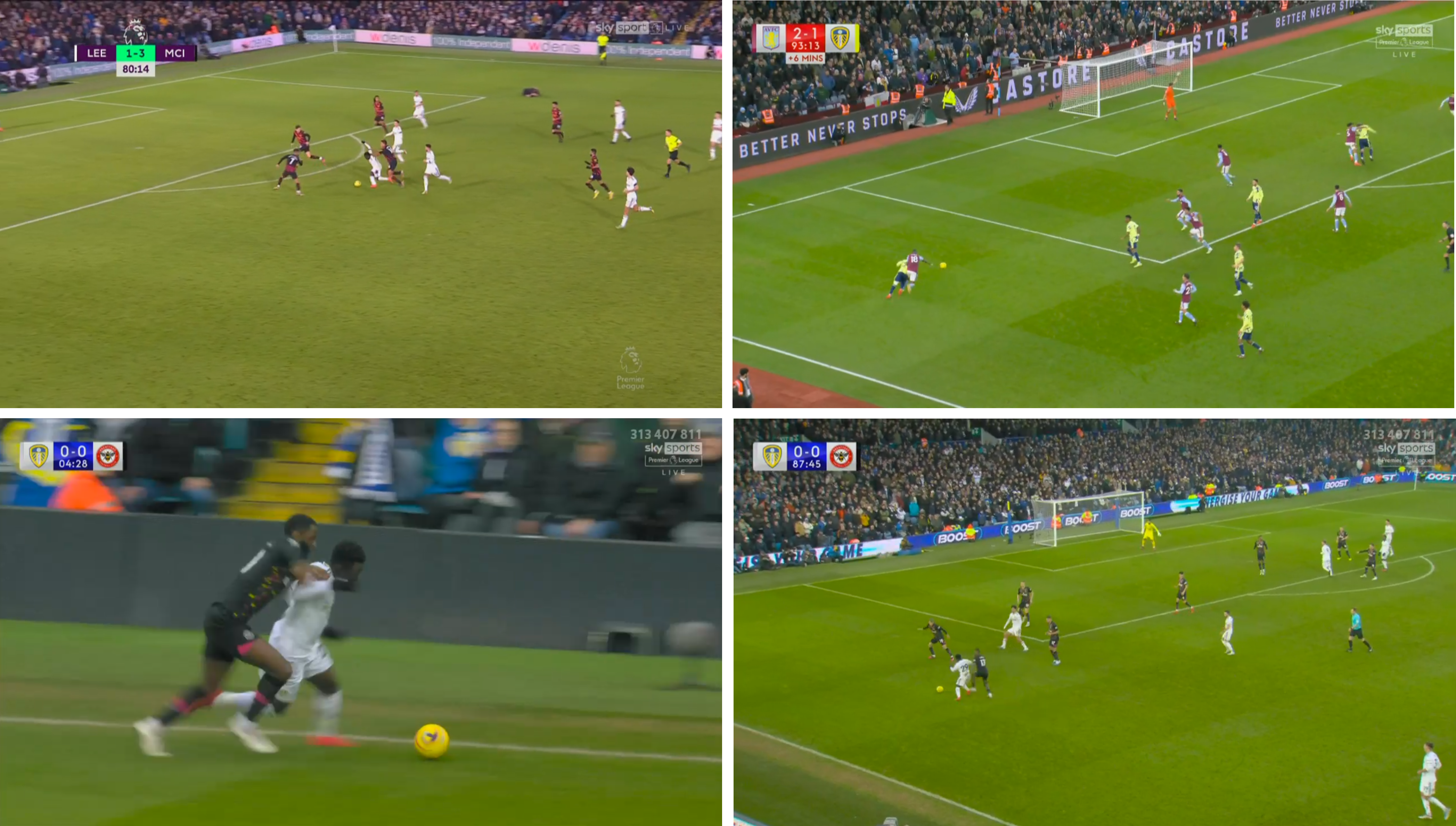
On the occasions when he’s not being cut down, Gnonto’s driving runs with the ball have quickly become a feature of his team’s attacking production. The Italian helps Leeds transition from deep, takes them through the thirds, and when he gets to the final stop, knows how to put defenders on their heels. All of it is achieved with a delightfully close control, even when he’s covering large distances at speed (as shown with his assist against Bournemouth last November).
Since the Premier League resumed post-World Cup, Kaoru Mitoma (704m) is the only midfielder or forward who has progressed the ball further upfield via carries than Gnonto (625m). And across the season on average, the Italian has been one of the league’s most punchy attacking players when travelling with the ball.
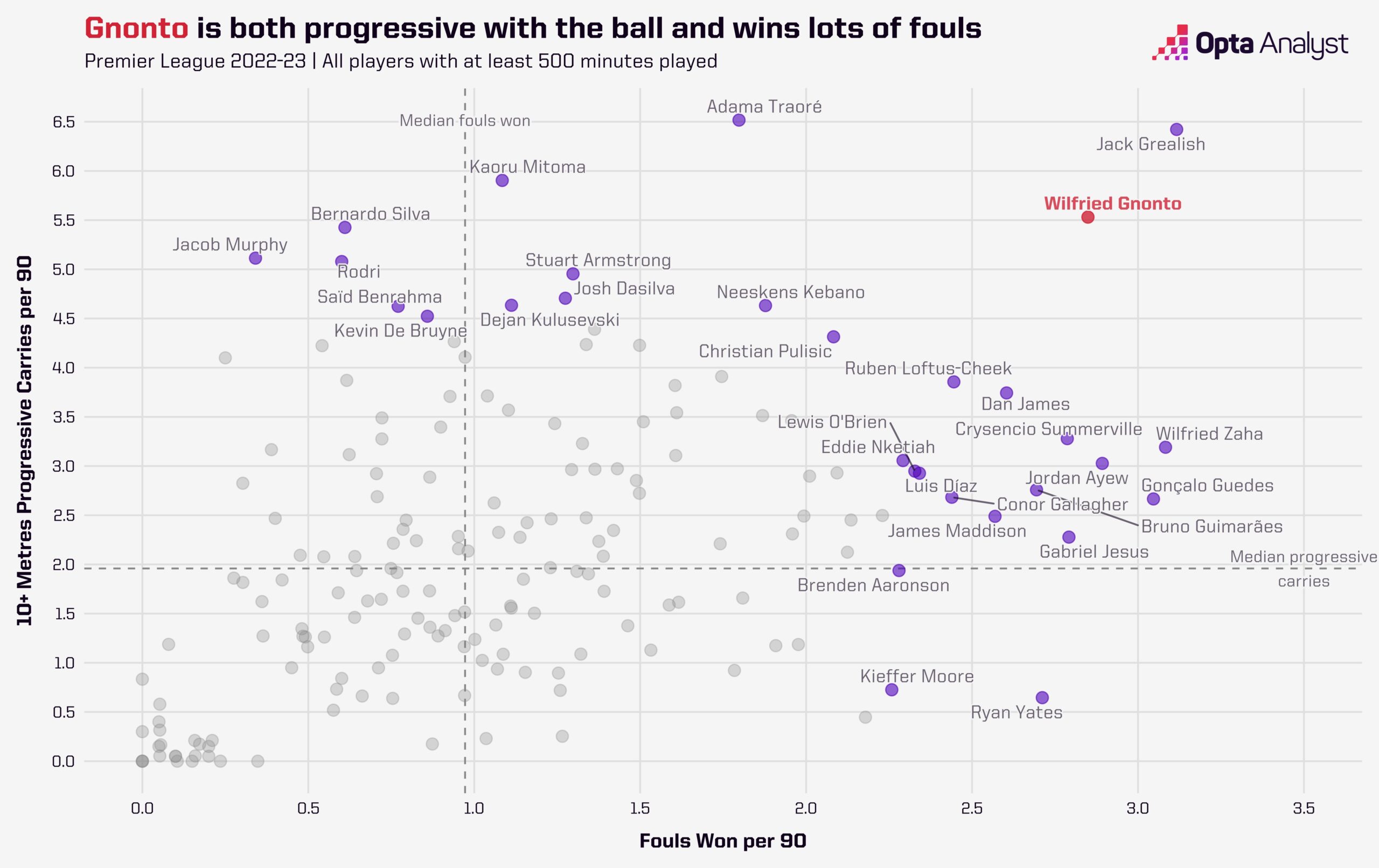
One of the main criticisms levelled at Jesse March’s side this season has been (and remains) their ability to break teams down outside of transition opportunities. With Leeds most typically setting up in a 4-2-2-2 and looking to swarm central areas, where they press well and play with limitless energy, that compression of the pitch can often result in his side struggling to shift the opposition and capitalise on the resulting spaces.
Those issues persist, but in Gnonto, Leeds have unearthed a self-sufficient player who stresses the opposition’s defensive shape from more general possession. He doesn’t only figure when space is abundant, but chips away from the outside of opposition blocks too – combining with players inside, splitting gaps with carries and backing players up with direct dribbles. Knowing what the teenager can do, Leeds are conscient of finding him as much as possible. No player in the Premier League has embarked on more dribbles than Gnonto (25) since the World Cup interval.
Particularly since his emergence, Leeds have made alterations to their shape in possession – or more specifically, who is responsible for opening up the pitch. Where earlier on in the season they would have brought both of their ‘wingers’ inside and drawn on their full backs to open the pitch, they now look to free Gnonto out towards the touchline and form a back three in their last line.
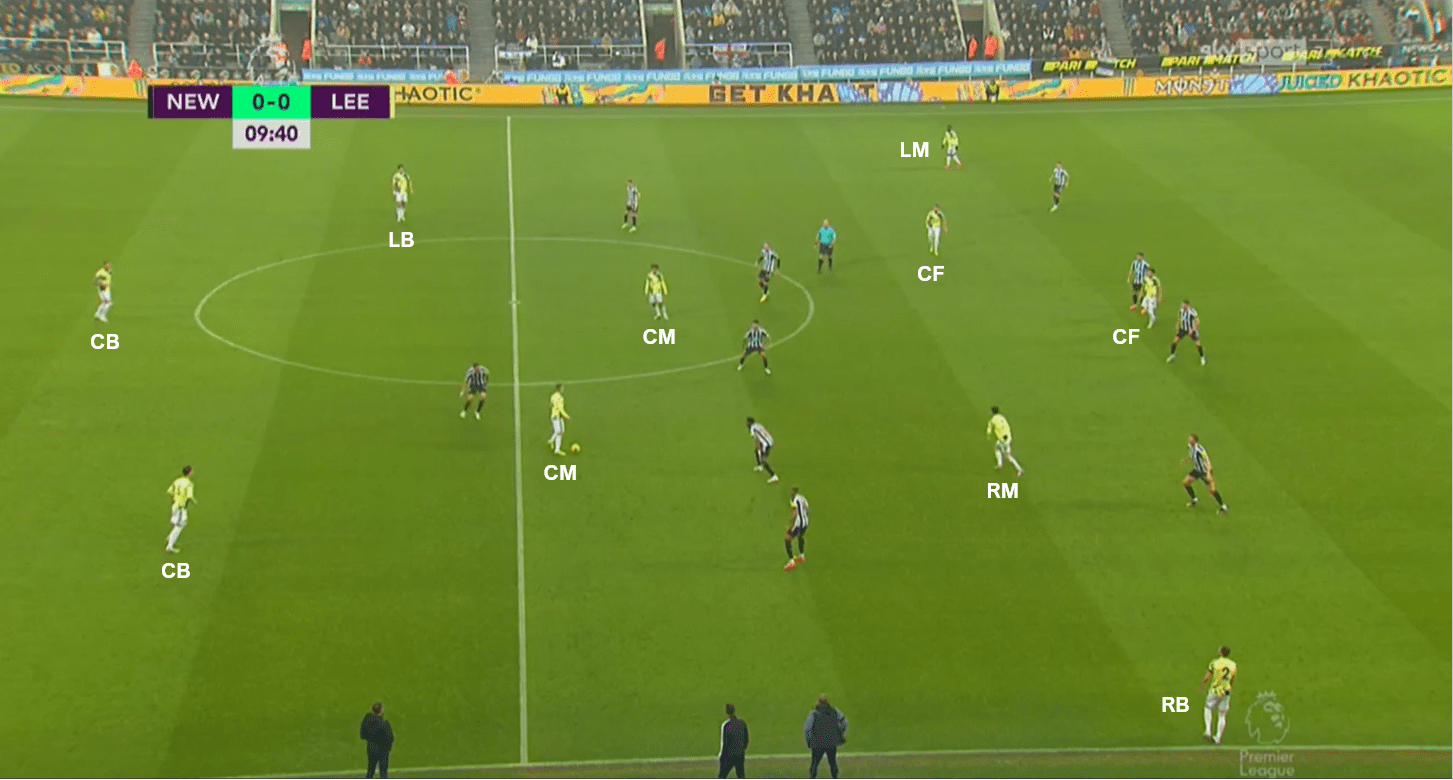
In their previous game at home to Brentford, Leeds used Gnonto up front in a 4-4-2 shape when they weren’t in possession, with Jack Harrison defending on the left of a midfield four behind. When Leeds did recover the ball, however, those two often switched positions in order to get the Italian opening up the pitch on the left. Finding him on the edge, where full backs are reluctant to follow him out, ensures smoother receptions than having to try and find passes in congested central areas.
There will be numerous reasons for the change in shape – and not just with Gnonto in mind – but there’s little doubting that it has potentiated his presence. Leeds needed an animator – and now they have one, they have reason to play through him.
Marsch’s side might look like a fairly typical Red Bull-inspired outfit – notable by their intensity, aggressive pressure, and transition-based football. But Gnonto has a way of placing his own game within the team’s wider style, as if he’s not always following the script. Viewers who watched Leeds’ game at Aston Villa on Sky might have heard Gary Neville say the teenager looked ‘like a Manchester City winger’ during his commentary, which is interesting given the team’s style of play could hardly be more different to that of Pep Guardiola’s side.
There’s a maturity to his game which, at just 19 years old, does tend to shock the viewer as it did with Neville a few weeks ago. His brace against Cardiff in the FA Cup – which became viral news following his Paolo Di Canio scissor-kick tribute – was that of a typical wide forward, attacking the space from out to in on the left side. But prior to the strikes, there was a level of subtlety in how Gnonto found his way to goal that goes beyond his years. His talent is expressed within a wider understanding of how to handle himself.
Before executing the scissor-kick there’s the dummy movements to unsettle his marker, followed by the subtle nudge while the ball was in the air to create separation. Then for the second, Gnonto shifts the ball inside and shapes to the far post – drawing a second Cardiff defender across – before reversing his shot to the near post between the legs of the full back.

It’s true that the teenager is Leeds’ most prolific ball carrier and their biggest source of thrust, yet he’s also the one who best evades the look of being hurried in his play, particularly given the context he finds himself in. Leeds are the team with the highest direct speed in the Premier League this term, which makes them liable to freneticism and an ensuing lack of precision. Gnonto accelerates the play when he can, but he also knows when to slow it down and invite attention towards him.
On the other side of the World Cup, he has received more passes in the opposition half than any other Leeds player (95). And among teams outside of the Premier League’s current top six, only Michael Olise (70) has received more passes in the final third than Gnonto (54) in this period. For a player who arrived at the club with zero short term expectations at first team level, he is now the one they look to in attack.
Of course, the upper limits of the Italian’s potential will be defined by how regularly he can put the ball in the net or pick out somebody else to do it. But at 19 years old, if all that were already there too – alongside the other ways in which he has benefitted Leeds – then his time in West Yorkshire would be elapsing very quickly.
After just six starts in the Premier League, there’s still plenty left to be discovered within view of Gnonto’s future. Is he a winger, a wide forward, or a second striker? Where does he truly fall on the spectrum between creator and scorer? For the moment he is Leeds’ catalyst, even if they can’t yet determine those questions.
At just €4.5 million, they know they’ve landed on something good – so good they seem to have even surprised themselves.
Enjoy this? Subscribe to our newsletter to receive five stories each Friday. It’s free.
